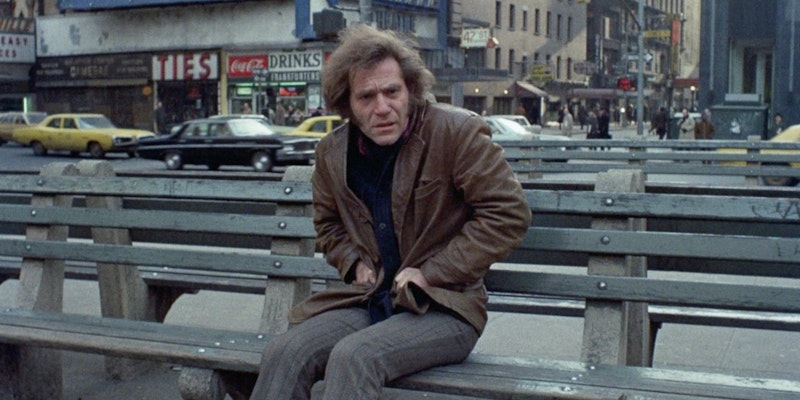Robert De Niro didn’t have to wait long until his name shot up from the fifth block of “also featuring” title cards to the top of movie posters—in 1970, he was 27, a working New York actor, and four years later he became the icon he’ll always be with The Godfather, Part II. No ramp up, no lean years, no struggle past the most supple portions of his career. By the time he became an instant superstar, he’d already worked with Brian De Palma, Roger Corman, and Ivan Passer. De Palma’s Greetings was a modest hit in the heady days of 1968 and 1969, warranting an even more raucous (and ultimately less profitable) sequel called Hi, Mom! in 1970. If De Niro hadn’t shot to the stratosphere in 1974, what would he be best remembered for today? The “Be Black, Baby” section in De Palma’s movie? Or the junkie brother in Bloody Mama?
Either is a safer bet than his small role as a vice cop in Passer’s Born to Win, shot in 1970 and released in 1971 to little fanfare or notice. Born to Win has been free to stream on Amazon for a couple years now, and the Criterion Channel is currently featuring it in their “Times Square” collection, among films as varied as Variety, The New York Ripper, The Gods of Time Square, So Fine, and Eyes of Laura Mars. Written by Passer from a story by David Scott Milton, Born to Win is a junkie drama exploding with life, a remarkably nervous and high-strung film that nails the frenzy of a drug hunt. George Segal stars, much more famous than De Niro in 1971, and while he’s of a different generation, he’s as riveting and authentic in another bummer classic from the early-1970s, John Huston’s Fat City.
That was a booze movie, but it feels like a dope high: a hazy, golden brown loop. Born to Win might give a lot of people the same second-hand panic most recently displayed by Uncut Gems, and the stakes are the same despite Sandler’s jewels and Segal’s needles: the chase is their life. De Niro’s biggest scene is with Segal and Hector Elizondo, the latter playing a flamboyant pimp and drug pusher. He picks up immediately that Segal has brought De Niro to set him up, and after peacocking his prices and his pure inventory about, he reneges on the deal, walking out. Later, Elizondo gives Segal and a drug buddy a couple hotshots—“rat poison and battery acid”—and his buddy fixes before him. He dies, but only after a bracing long take of the two excitedly getting their works ready in an anonymous bathroom in a Midtown office building. Passer holds the shots as Segal nervously opens the bag, pours a shot into the spoon, cooks it, hands the needle to his friend, who’s just been jumping up and down and laughing and giddy the whole time. They both are—and then he dies an agonizing, screaming death.
At only 89 minutes, Born to Win is packed with incident and curves that keep it from being either yet another preachy or dreary anti-drug movie (The Panic in Needle Park) or a thoroughly detached and deliberately depressing New Hollywood film. Nearly all of the American classics of the 1970s have downer endings, but Born to Win manages to reach an ending even more unsettling than death or imprisonment: eternity.
At the end, after being chased and nearly killed several times, Segal sees Elizondo again. Elizondo gives him a few bags. Segal asks, “What are my odds?” Elizondo shrugs. “Born to win,” says Segal as he stalks off up the East River. The end music has already begun, and you’re sure this will be the final shot of the film, but then there’s Segal sitting at the same Times Square bench where he began, looking even more haggard, jonesing and waiting for a man, any man, in the exact same spot where he began—the only thing missing is his dead friend. Passer holds this shot for just a couple of seconds before immediately cutting to the end credits, bright taxi cab yellow font against a gorgeous sky blue background. Like Fat City, Born to Win is a circle; during that failed setup with De Niro and Segal, Elizondo says to no one in particular, “The only good addict is a dead addict.” Passer doesn’t need to show Segal OD’ing or going to prison or getting shot in the back—the circle of this man’s life, the same circle of every addict’s life, is rendered with shocking clarity in that jarring final shot.
De Niro’s presence as Segal’s oppressor gives Born to Win an added layer of disappointment and death: Paula Prentiss is billed second, despite barely appearing in the movie, and while I love her, her career didn’t survive the 1970s. Neither did Karen Black’s, but she certainly makes an early impression as Segal’s girlfriend. Elizondo is also a treasure trapped in the 1970s, and while Segal remained well-known and well-employed for the rest of his life, he never became an icon. Having a soon-to-be superstar play a petty, scummy vice cop intent on destroying Segal makes it all the more painful, because even if he’s alive on that bench at the end, we know that all he’ll ever do is watch his friends succeed or go straight into the ground.
—Follow Nicky Otis Smith on Twitter and Instagram: @nickyotissmith

